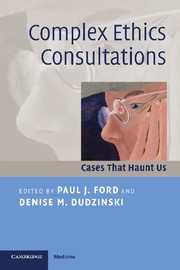Book contents
- Frontmatter
- Contents
- List of contributors
- Foreword
- Acknowledgments
- Introduction: Live and learn: courage, honesty, and vulnerability
- Part I Starting at the beginning: prenatal and neonatal issues
- Part II The most vulnerable of us: pediatrics
- Part III Diversity of desires and limits of liberty: psychiatric and psychological issues
- Part IV Withholding therapy with a twist
- 13 Listening to the husband
- 14 You're the ethicist; I'm just the surgeon
- 15 Haunted by a good outcome: the case of Sister Jane
- 16 Is a broken jaw a terminal condition?
- Part V The unspeakable/unassailable: religious and cultural beliefs
- Part VI Human guinea pigs and miracles: clinical innovations and unorthodox treatment
- Part VII The big picture: organizational issues
- Conclusions, educational activities, and references
- Index
16 - Is a broken jaw a terminal condition?
Published online by Cambridge University Press: 03 May 2010
- Frontmatter
- Contents
- List of contributors
- Foreword
- Acknowledgments
- Introduction: Live and learn: courage, honesty, and vulnerability
- Part I Starting at the beginning: prenatal and neonatal issues
- Part II The most vulnerable of us: pediatrics
- Part III Diversity of desires and limits of liberty: psychiatric and psychological issues
- Part IV Withholding therapy with a twist
- 13 Listening to the husband
- 14 You're the ethicist; I'm just the surgeon
- 15 Haunted by a good outcome: the case of Sister Jane
- 16 Is a broken jaw a terminal condition?
- Part V The unspeakable/unassailable: religious and cultural beliefs
- Part VI Human guinea pigs and miracles: clinical innovations and unorthodox treatment
- Part VII The big picture: organizational issues
- Conclusions, educational activities, and references
- Index
Summary
Case narrative
The request for ethics consultation came from the trauma unit charge nurse on a Friday afternoon. My secretary, using the “Request for Consultation Information Form” my colleague and I developed, took the call. This form has space to list basic facts, including “Patient history, situation, and prognosis.” It also contains two key questions, the answers to which are to be written verbatim. First, “What is the reason for this call?” Second, “What does the caller hope to accomplish with this inquiry?”
From the form I learned the patient, Mary Jackson, was an 83-year-old recent widow in a step-down bed in the trauma unit. The reason for the call was, “The patient is DNR [do not resuscitate], but the physicians have decided to put her back on oxygen.” As for what the charge nurse hoped would be accomplished, my secretary had written, “Was it ethical for the doctor to order oxygen for the patient?” Under “Patient history, situation, and prognosis” was this:
Patient had auto accident earlier in week. Fractured jaw & broken elbow. Pt has dementia. Daughter doesn't want anything done. No surgery to her jaw and was taken off oxygen. Has Do Not Resuscitate (DNR). Attending put her back on oxygen because she was struggling to breathe. Nurses feel she would be fine with surgery and food (taken off food because she was scheduled for surgery) in a nursing home.
Review of Mrs. Jackson's electronic record revealed she was admitted on Monday after sustaining a variety of minor orthopedic injuries – fractured right wrist, dislocated right elbow, broken right rib, and mandible fracture – as the result of her single-vehicle accident.
- Type
- Chapter
- Information
- Complex Ethics ConsultationsCases that Haunt Us, pp. 126 - 132Publisher: Cambridge University PressPrint publication year: 2008
- 1
- Cited by



